Raymond McCreesh: the man behind IRA playground row
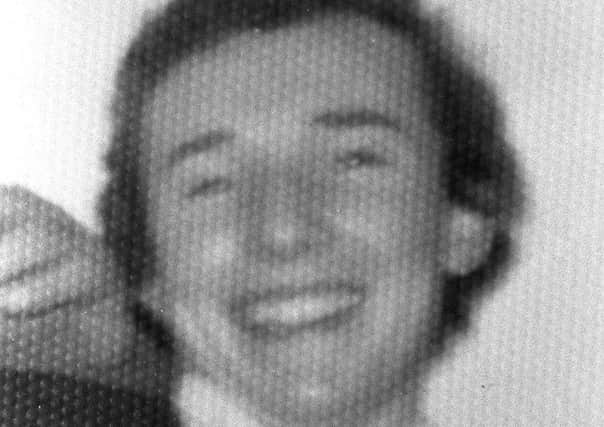

But who was the south Armagh man who died in May 1981, almost four decades ago, and what did he do to inspire such devotion that banners recently erected in the playground named after him declare him to be “our hero”?
In June 1976 he was one of four IRA men arrested while launching an attack on any Army observation post at Belleeks, just west of Newry. He was later given 14 years for attempted murder, conspiracy to murder, possession of firearms and IRA membership.
Advertisement
Hide AdAdvertisement
Hide AdHe and three accomplices were carrying four weapons used in the Kingsmills Massacre five months previously and just five miles south. The atrocity saw 10 Protestants pulled out of their work minibus by the IRA and shot dead in a purely sectarian attack.
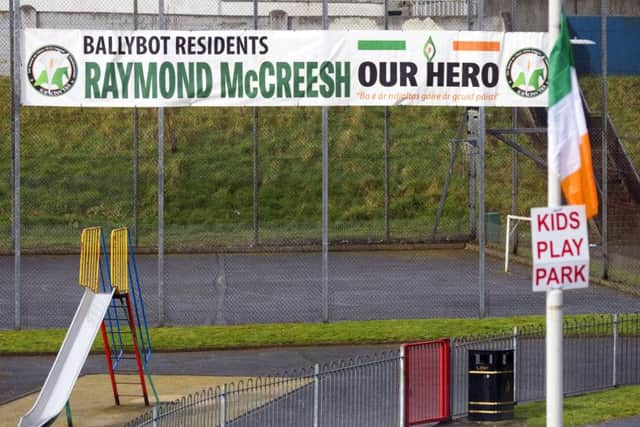

The seventh of eight children, McCreesh was born in Camlough in 1957 to parents James, a local council worker, and Susan.
Sinn Fein published a detailed profile of him after his 1981 death, describing him as “a quiet, shy and good-humoured republican”, who although captured at only 19, already had “almost three years active republican involvement” behind him. He was “one of the most dedicated and invaluable republican activists ... who could show leadership and aggression where necessary”.
At school he was regarded as a “hothead” in history classes and joined the IRA youth wing early in 1973, graduating to the IRA later that year.
Advertisement
Hide AdAdvertisement
Hide AdHis first job was at a Lisburn steel company. However, in a chilling echo of Kingsmills, Sinn Fein said he gave the job up because he travelled daily “in a bus” from Newry and was concerned by “the prevailing high level of sectarian assassinations” which made him decide such a regular route was simply “too risky”.
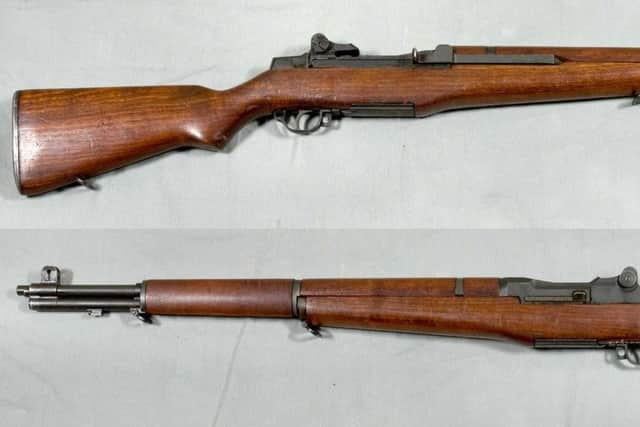

Instead he took up a milk round, which Sinn Fein said allowed him to observe soldiers and other “untoward” activity; he was “very keen to suggest and take part in operations”. At least one customer was shot by the IRA during the period he delivered their milk.
Police records on the weapon he was arrested with, an M1 Garand, find it was only used during his short IRA career. Aside from Kingsmills, it was used between March 1974 and June 1976 to murder an RUC constable, a soldier, a postmaster and a UDR soldier and for the attempted murder of a postman. It is not known for certain if McCreesh fired any of these shots.
He launched his last attack on June 25 1976 when he, Danny McGuinness, Patrick Quinn and one other volunteer approached the Army post at Belleeks. However, soldiers spotted them first and opened fire. McCreesh and Quinn fled to a nearby house where McCreesh’s first action was to phone the RUC, pressing them to save him from pursuing soldiers.
Advertisement
Hide AdAdvertisement
Hide Ad“I rang 999 to the police at Bessbrook,” he later told the RUC. “I said who I was and the Army had me surrounded and that we would surrender to the police.” He added: “I thought I was going to be shot.”
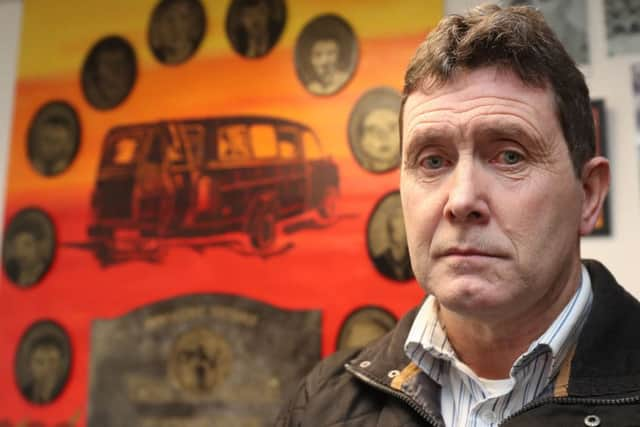

In the event they surrendered to the soldiers and were arrested.
In his possession were several magazines of armour piercing rounds for the Garand, which were known to virtually destroy the human body on contact.
~
Who used his weapon to kill in Kingsmills Massacre?
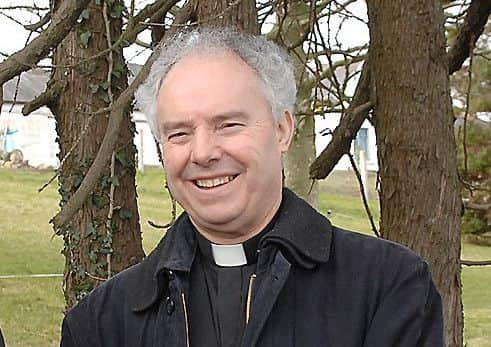

~
Unionists are particularly angered by a council playground being named after McCreesh because of his link to the Kingsmills massacre.
Advertisement
Hide AdAdvertisement
Hide AdAll four IRA weapons used in McCreesh’s last operation were used at Kingsmills – including his semi-automatic.
The Historical Enquiries Team (HET) report on Kingsmills said McCreesh and accomplices Daniel McGuinness and Patrick Quinn were arrested five months after Kingsmills with four weapons used in that atrocity. A fourth IRA man escaped.
But HET said firmly that it could not assume the trio were involved in Kingsmills, as IRA weapons were stored centrally and could have been used by others for that atrocity.
Statements by the trio seem to confirm their weapons were stored centrally – but may also suggest they each had a favourite firearm.
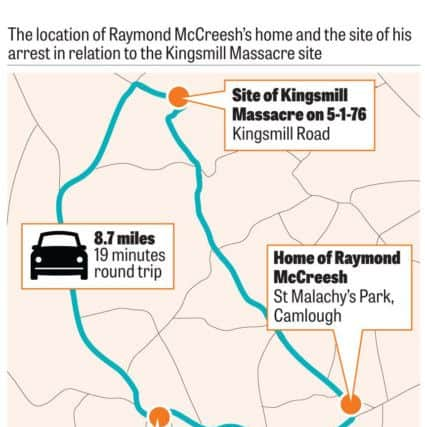

Advertisement
Hide AdAdvertisement
Hide AdMcCreesh told the RUC he was picked up for his last operation by a car which contained the four weapons.
Asked what gun he took, he replied: “The Gerald” – understood to be the M1 Garand he was arrested with.
McGuinness said: “We each selected a weapon...”. Similarly, Quinn told police: “There was a weapon for each of us. I took an Armalite, McGuinness took an Armalite and McCreesh took the Garand.”
McGuinness admitted this had been his “first major operation” but McCreesh would reveal nothing about his recent IRA activity. “I can’t tell you ... You know what would happen to me...” was all he would reveal in his statement to the RUC.
Advertisement
Hide AdAdvertisement
Hide AdFormer Det Ch Supt Norman Baxter and former Special Branch Det Insp William Matchett both agreed that IRA weapons would normally be stored centrally between operations. However, both also said some IRA men may have had favoured weapons.
Mr Matchett said most IRA men “normally got their favoured” weapon. He added: “Any ‘volunteer’ caught with a weapon, it is likely that its history is also theirs.”
Former IRA member Shane Paul O’Doherty said HET’s assertion that an individual could not be tied to a weapon’s history was “not my experience at all”.
“People liked to become familiar with their weapon,” he said. “It’s utter nonsense to imagine an IRA volunteer would be handed a weapon with which he was unfamiliar, going out on an operation which might cost him his life.”
Advertisement
Hide AdAdvertisement
Hide Ad• The location of McCreesh’s arrest, the Kingsmills Massacre and his home in Camlough were quite close to each other; less than nine miles apart on a round trip, a journey of only 19 minutes.
~
‘He should have been charged for Kingsmills’
~
Bessbrook man Colin Worton strongly believes that Raymond McCreesh took part in the Kingsmills Massacre - in which his brother Kenneth was killed.
He does not accept the assertion in the Historical Enquiries Team’s (HET) report that six people convicted for other attacks with Kingsmills weapons were not necessarily also involved in that atrocity. McCreesh was one of those six, HET said.
“These terrorists based their style on the British Army and still do today,” said former UDR soldier Colin. “In the British Army you are given a weapon which you continually use, you are personally responsible for it.
Advertisement
Hide AdAdvertisement
Hide Ad“The police were wrong not to charge McCreesh and company with Kingsmills; at the very least this would have forced them to come up with an alibi.
“In my opinion it was not for the police to assume that the weapons McCreesh and company were arrested with five months after Kingsmills were not personal weapons.
“You have to take into account that these were IRA terrorists caught red handed and that some months earlier, IRA terrorists at Kingsmills massacred 10 innocent civilians.
“Raymond McCreesh joined the IRA at least one year before Kingsmills. He was caught five months later with a weapon which was used at Kingsmills. No-one can seriously suggest that when he was arrested it was his first time out with his IRA murder gang. He would have been very unfortunate to be caught on his first operation.”
~
Advertisement
Hide AdAdvertisement
Hide Ad‘My brother was not involved ... families know these things’
~
However A brother of Raymond McCreesh has told the News Letter he is certain he was not involved in the massacre of 10 Protestants.
Defending his brother, Fr Brian MacRois noted that Raymond was never arrested for the atrocity.
In his brother’s defence, the HET report on Kingsmills lists the age and address of nine top suspects – none of them from Raymond’s home village of Camlough.
Advertisement
Hide AdAdvertisement
Hide AdBut on the other hand, HET said it had over 60 suspects. And the PSNI has told the Kingsmills inquest that police did not arrest all suspects, believing many would give nothing away – while absorbing intelligence from their questions.
Colin Worton, whose brother Kenneth was killed at Kingsmills, believes Raymond was involved: “Are you telling me he took the night off when such a massive operation was happening on his doorstep?” he asked.
Invited to comment on the claim, Fr MacRois insisted his brother was not involved. “Families know these things,” he said, declining to elaborate any further.
Fr MacRois said Mass for the hunger strikers in prison, and his defence of Raymond at the time, “My brother is not a criminal”, became an iconic slogan.
Advertisement
Hide AdAdvertisement
Hide AdHe defended his brother again in 2011 when newly released state papers, found by historian Eamon Phoenix, appeared to show Raymond had asked for nourishment in his last days – but was talked out of it by his family.
“The alleged statements by myself and my brother are very, very inaccurate,” Fr MacRois said in 2011.
Raymond McCreesh died after 61 days on hunger strike on 21 May 1981, pressing for recognition as a political prisoner. Three days after the strikes ended the government granted some republican demands, causing strong unionist protest.
But the protest had a much bigger outcome, the relaunch of Sinn Fein into electoral politics, setting the party in the direction of the peace process and the Good Friday Agreement, eventually rivalling the DUP as the largest party in Northern Ireland.